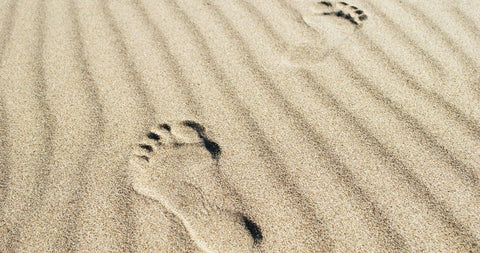
Home remedies for Plantar Fasciitis
Looking for some ways to help alleviate the discomfort of plantar fasciitis at home? We’ve got some handy information to help you get started.
What is plantar fasciitis?
Plantar fasciitis is the clinical name for damage to the plantar fascia, a thick band of connective tissue that runs along the base of the foot, from heel bone to toes. The plantar fascia is a tough and resilient band of tissue that helps maintain your foot’s arch. It’s also key in absorbing shock as you walk or run and helps to stabilise the metatarsal joints during impact with the ground.
Plantar Fasciitis typically presents as pain that starts gradually and grows over time. It’s often first felt in the heel but can radiate throughout the whole band of tissue. Often, symptoms are worst in the morning. Pain also often goes away during exercise but is present afterwards. You may also find it hard to raise your toes off the ground, according to the NHS.
How to watch out for plantar fasciitis
Some people have feet that are more prone to experiencing plantar fasciitis. For example, those who have flat feet (Pes Planus) may be more likely to suffer from arch pain. However, there are also lifestyle factors that can increase the chances of developing the condition, such as spending a long time on your feet at work or taking part in activities like running, dancing, basketball, tennis and step aerobics.
The kind of ground you are standing, walking or running on can make a difference too. Very hard ground offers less give and that means the shock of your weight is taken solely by your foot. Some people also suffer from plantar fasciitis during pregnancy, when they’re not only carrying extra weight but also experience hormonal changes which can relax muscles and cause flat feet.
Things you can do at home to ease plantar fasciitis
While you can use painkillers to help alleviate the pain and should speak to a health professional if you need a diagnosis and advice, there are some remedies you can try at home to help ease the symptoms of plantar fasciitis.
Rest, raise and ice the affected foot when possible
Resting is a very important part of reducing pain caused by plantar fasciitis. Try to avoid spending long periods on your feet and, when you’re resting, keep your foot raised on a stool or similar. You could also apply an ice pack to the painful area for up to 20 minutes every two to three hours. A bag of frozen peas in a towel can be used as an alternative.
Wear well-fitting and supportive shoes
Well-fitting shoes with arch support and cushioning for your heels can also help ease the pain of plantar fasciitis. It’s also a good idea to avoid walking barefoot on hard surfaces as well as skipping shoes that don’t offer support, such as flip flops. Likewise, avoiding high heels or pointy shoes can be beneficial too.
Use insoles in your shoes
Using suitable insoles in your shoes can also provide relief. For example, Scholl In-Balance® Orthotics Plantar Fasciitis Pain Relief Insoles are clinically proven to provide pressure relief to the base of the foot. They have been specifically designed by biomechanics experts to provide a 3-in-1 action to help alleviate the pain associated with plantar fasciitis and are available as large, medium and small insoles.
Choose gentle exercises and stretching
While suffering from plantar fasciitis, it can be a good idea to experiment with exercise that doesn’t put pressure on your feet, such as swimming or underwater aerobics. There are also some gentle stretches that can could help. You may want to speak to your GP or a physiotherapist about which ones are suitable for you.
Watch out for what’s underneath your feet
Because hard ground can contribute to or exacerbate plantar fasciitis, one thing you can do is pay attention to what’s underneath your feet. If you’re a runner, try and stick to parks and grassy areas where possible. If you take part in step aerobics or sports like basketball, check if your facilities have sprung floors that are designed to absorb shocks.
Lose weight if you’re overweight
The pressure that’s put on our feet can be exacerbated by the amount of weight that we’re carrying. This means that if you’re overweight, you could be putting extra pressure on your feet. Losing weight can sometimes help alleviate the pressure on the plantar fascia.
Everyday support for plantar fasciitis
When you’re looking for a way to support your feet throughout your everyday activities, our Plantar Fasciitis Pain Relief Insoles offer shock absorption, stabilisation to help position your foot in your shoe, helping to provide better support, as well as redistribution of pressure to spread the weight
